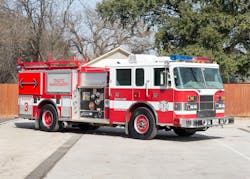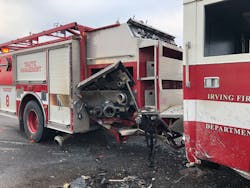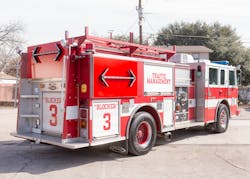This year’s Firefighter Safety Stand Down Week focused on firefighter safety along roadways following a dangerous and deadly year for firefighters along U.S. highways.
One fire department in Texas addressed responder safety along highways several years ago as part of the fire chief’s Executive Fire Officer (EFO) program utilizing apparatus that had long served the community as frontline suppression units. Irving, TX, Fire Department Chief Victor Conley was assigned to the community risk reduction working group with his EFO program, but one of the biggest risks in his community is roadway incidents. The department protects 39 miles of limited access highways and, on average, responds to more than 850 vehicle crashes on those roads annually.
Crash sparks change
In July 2015, Irving Ladder 52 was called to block traffic on a busy interstate where police were conducting an investigation. After an hour, an 18-wheeler hit Ladder 52’s apparatus at close to 70 mph, and the big rig caught fire.
Two firefighters and a police officer were injured, and the driver of the tractor-trailer died. “We were lucky not to lose our firefighters,” Conley said.
As Conley conducted research for his EFO program, he found that nine Irving Fire Department apparatus were struck while blocking traffic in just five years. Two of those apparatus, including Ladder 52, were scrapped after the accidents.
Those accidents caused more than a one-year period during which the apparatus were out of service for repairs, and they sustained more than $1.5 million in damages.
Blocker units go into service
The city was preparing to auction off several reserve pumpers that served the city well when Conley created the “blocker” concept and placed two of them into service in 2018.
The rigs—originally placed into service between 1995 and 2001—already were equipped with warning devices and had fire department and safety graphics. Conley said it only cost about $3,500 to fully outfit each of the two blockers with new equipment, including directional arrow boards on the tailboard and over the high side compartments at the back of each side of the body.
To add weight to the apparatus, Conley said they added ZapZorb Premium (used in baby diapers) to the booster tank. That solidifies and avoids any ongoing maintenance for potential leaking booster tanks. If they decide to sell the unit, they can clean the tank by melting the ZapZorb using salt.
Equipment for traffic management, including cones and flares, still are carried on the rigs, in addition to absorbent to clean spills. The blocker units are strategically assigned to two ladder companies that have quick access to the various highways in the city. When the units are called, one firefighter drives the blocker unit to the scene while the ladder company follows to pick up the firefighter once the rig is positioned. A fire crew on scene returns the blocker to the station, keeping the ladder company in service.
If the ladder company is dispatched to the call, the firefighter who drives the blocker then joins the ladder crew at the scene once the rig is positioned.
Conley said the apparatus are considered frontline units and are fully insured. This allows the city to collect insurance money if the units are damaged and apply that money toward a new vehicle.
Blockers pay off and expand
In March 2019, Conley said Blocker 8 proved its worth. While blocking a crash scene, it was struck by a vehicle operating at a high speed. No firefighters or police officers were injured, though the blocker rig was destroyed.
In the neighboring city, Dallas Fire Rescue (DFR) implemented the blocker program after determining that fire apparatus were struck 62 times over a three-year period. They placed two blocker units in service at opposite sides of the city where data showed that they suffered the highest number of struck-by incidents. The booster tanks were filled with sand to add weight.
Only six days after DFR’s blockers were placed into service, one of them was struck. No injuries were reported, and a brand new ladder truck that only was in service for a week escaped damage.
About the Author
Peter Matthews
Editor-in-Chief/Conference Director
Peter Matthews is the conference director and editor-in-chief of Firehouse. He has worked at Firehouse since 1999, serving in various roles on both Firehouse Magazine and Firehouse.com staffs. He completed an internship with the Rochester, NY, Fire Department and served with fire departments in Rush, NY, and Laurel, MD, and was a lieutenant with the Glenwood Fire Company in Glenwood Landing, NY. Matthews served as photographer for the St. Paul, MN, Fire Department and currently is a photographer for the Fort Worth, TX, Fire Department.



